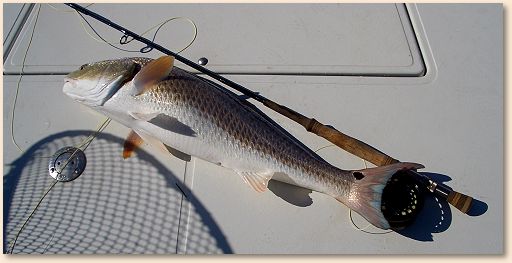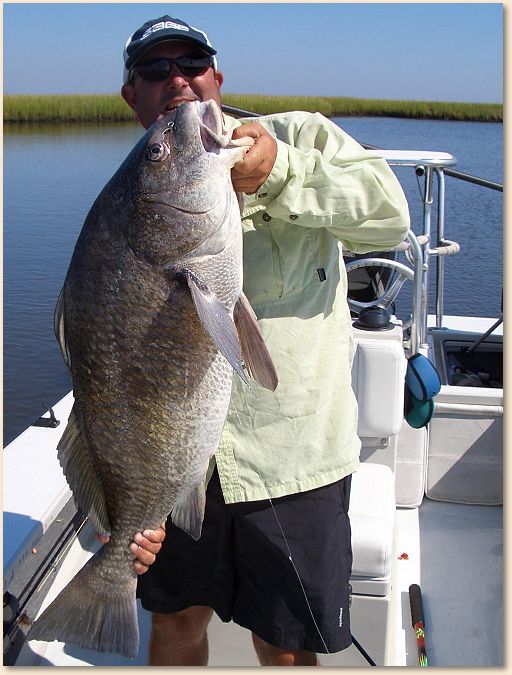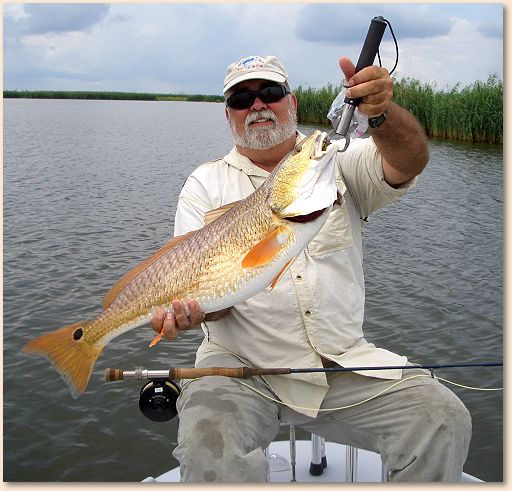Having had the best fishing in the world in Louisiana
south of New Orleans why would anybody go anywhere else?
Well, the rest of Louisiana has some places that rival
what I have already seen so I had to look at one more:
the part of the delta called the Biloxi Marsh. It was
every bit as good as anything I have seen to date,
perhaps better in some ways. To fish it takes a little
bigger boat at times though.
You get to the "marsh," not from Louisiana, but from
Waveland, Mississippi. It makes sense if you look at
a map and notice that the tip of the Mississippi river
delta is south of Mobile, AL. The marsh is a collection
of islands on the west side of the big river and it only
takes a nine mile run over a big bay to get there. That
can be the problem. Just a little wind from anywhere and
that boat ride can feel like you are trying to round Cape
Hope. Especially if in a little flats boat.
Brian Carter, a guide out of both Mississippi and Louisiana,
called and asked if I would like to "explore" the marsh.
He and I had tried to work this up a year ago but that
Katrina event really tore up the place and put everybody
"off" any plan of any sorts. He also wanted my boat. He
has a Hellsbay 16' Waterman 16 and I have a Hellsbay 18'
Marquesa. He fished the day before and wanted some more
comfort. My boat is made to take some heavy water. His
is not.
I couldn't get there that night but left at 0400 the next
day and we set off at about eight in a very light west
wind. Crossing the bay is a cinch for any boat with
conditions like that. Once past the Nine Mile marker
south of what was once a real nice part of Mississippi,
we were out in a vast area of reed covered flat islands.
It is all shallows and fish were just about anywhere we
looked.
I say "use to be" a nice part of MS, as the lodge I stayed
at was a big house on ten-foot pilings beside a canal three
miles inland from the gulf. The water got into the attic,
as it was 22 feet deep in that neighborhood. Until you
stand and see a watermark on a telephone pole in front
of you, the depth and meaning of that wave cannot be
understood. The area from the bay to the big freeway six
miles inland and beyond was under with the storm surge and
still looks like a little bit of hell on earth still. The
debris is mostly cleaned up but all houses are in some sort
of repair or rebuild process. There are few street signs
or landmarks left from before.

The first poling stretch of about a quarter mile of an
inside flat and adjoining drains provided about twenty
real nice shots at reds. They were not big but I got
half to the boat with the largest being thirteen pounds.
The smallest was around six. One particular pair of fish
we found in a deep section of the drain boggled the mind.
They were black drum and one was almost white and probably
around four feet long. I hooked that one first and while
the fish tried to continue eating the hook fell out. The
second cast got scooped up by the smaller fish. It stayed
hooked and after a setting of the hook tried to continue
its' activities too, until it discovered it was hooked
to something. I pulled and it pulled a bit before it
saw the boat. Off the fish went with me having little
control or stopping power with the nine-weight rod in my
hands. I did have 20-pound class tippet so I could put
pressure of some magnitude. I think the fish stopped
when it realize its' partner was left behind or it got
too shallow.
I was allowed to pull the monster back to the boat but
only until it saw the other fish and it left again to go
over to the white fish about forty feet away. I pulled
even harder and finally got him coming to boat at my whim,
not his. Once near to the boat he easily left again and
we went through this several more times before I got the
upper hand and Brian could get the nose of the fish in our
net. It took all of ten minutes to get to this point and
another few minutes to get a good enough grip on the rest
of the fish for both of us to scoop it into the boat.
Unhooking was not a problem as it was just in the lip but
hoisting the fish up for a picture was, as I had to take
the happy snap leaving only Brian to hold it up. The Boga
grip went to 30 pounds so we had to estimate the weight
of this brute. I have had a 43-pounder to the boat and
Brian has had them up to 49. This fish was not as long
as they were. It was thicker than I remember the other
one to be and this one sure fought harder than any of
the big black drum I have landed. We figured it was
"one of the largest" we have ever landed between us.
It was probably between thirtyfive and fourty pounds.

Once revived and sent back to the pond, he casually
swam back to the side of the other fish and started
eating again. One was enough and the two of them
had plenty to talk about as it was. Our guess was
he was telling a story of being abducted by aliens
and having a physical exam while being starved of
oxygenated water. The poor fish will have to live
with the scorn of all those non-believers for the
rest of his life. Black drums this size, are probably
over fifty years old and can live a lot longer than that.
The largest of them are much bigger than these we were
playing with.
Back to the red fishing, we almost got caught in a
falling tide on a flat making Brian work overtime
to get back to deep water. Our next run was off a
point and a long bank in the lea of the wind next to
deep water. Our first half dozen fish were large and
very spooky. They ran instead of eating the fly and
this was nothing like the others before. A hundred
yards later they were still running away. About that
time I saw a fish coming at us head on and it was a
monster, if a red. It turned out to be a black-tipped
shark making a run down the beach and that probably
was the reason the reds were not ready to play. I
tried to hook it but would have lost a fly if I had
been successful. Just after that the reds started
acting like fish again instead of food.
I had started with the first couple fish of the day
with poppers and went back after catching a couple
more with the crab patterns. A reason for change
was the bottom being all covered with clods from
the island being ruined in the big storm. Having
a hook on the surface was easier and the "takes"
are really dramatic that way. Brian fished a little
from the platform and he and I got the rest of the
reds for the day.
The last couple of runs down shorelines did not
produce fish, as the sun angle did not allow early
enough pick-ups before spooking them. We declared,
"Rule number one." That rule is: "I will not waste
your time if you will not waste mine." Twenty
reds and a black was good for a day "exploring."
We started home.
This is where the problem with this area comes in.
After the morning lull in the winds they picked up
to 10-15 mph and stayed that way. The west-northwest
wind had the run back at a quartering left head wind
and the waves at two feet or slightly more but really
messed up. It looked like a washing machine looking
through the round window in front. Brian was driving
and adjusted the trim to run at about 25 mph with little
water getting us as we both stood behind the console.
It was rough as a cob but only lasted twenty-five minutes
or so. He did an expert job of running the bumps like
a downhill skier to keep us from slamming around too
much. This boat is made for this stuff but the lodge
owner, also out fishing with four people in a 20 ft.
bay boat, got the customers completely drenched as he
could not maneuver to miss the big bumps as well. A
lady coming off his boat asked us why we were not wet.
I told her we flew back.
The lodge there costs $50 a person and fishing with
Mike the owner with the big boat is probably doable
most of the time. We both cancelled the next day
with the winds forecast at 25 mph. Brian and friends
are going to get a big mother boat to tow the flats
boats out and back on most days. Instead of getting
wet on the way to fish, you can have a nice breakfast
and coffee while doing the 45-minute passage. They
will be set up by spring next year or perhaps sooner
depending on the difficulty finding the correct mother
boat. Waveland is only three hours or less from Fort
Walton Beach and offers an alternative to fishing south
of New Orleans. It takes me 4.5 hours to drive over to
the N.O. flats. Brian will fish either place depending
on conditions. The far place is good on an east wind
and that makes the marsh too full of water. A west wind
has the opposite affect on the two places.

I think I will be able to pass my 200 redfish a season
average easily with back ups like the marsh for bad days
on the N.O. flats. Oh, the big fish wonder around these
flats all winter too. I plan to spend a lot of time
chasing them this winter. Ask me for specifics on
contacting Brian or Mike. ~ Captain Scud Yates
Sept 2006, scudyates@cox.net
|







